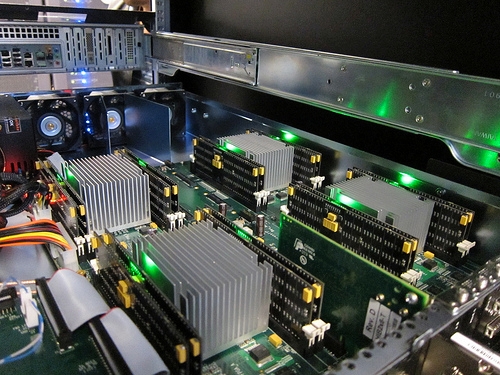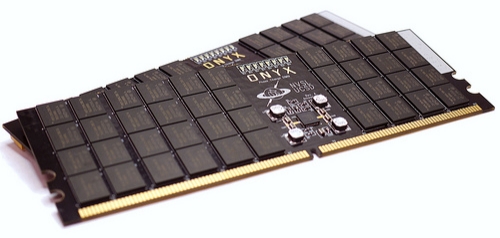June 3, 2011 — University of California, San Diego (UC San Diego) faculty and students, with industry partners Micron Technology, BEEcube and Xilinx, created a phase-change memory (PCM) solid-state storage device (SSD) with 7x speed improvement over current SSD technology. The PCM SSD’s performance is thousands of times faster than a conventional hard disk drives (HDD).
 |
| Photo 1. Inside the Moneta storage array with PCM modules installed. Image courtesy of Jacobs School of Engineering. All rights reserved |
The device, "Moneta," is the product of the Computer Science and Engineering department at the UC San Diego Jacobs School of Engineering.
To store data, the PCM memory chips switch the chalcogenide alloy between a crystalline and amorphous state based on the application of heat through an electrical current. To read the data, the chips use a smaller current to determine in which state the chalcogenide is.
 |
|
Photo 2. Moneta’s custom-built "Onyx" phase-change memory module. Image courtesy of Jacobs School of Engineering. All rights reserved |
Moneta incorporates Micron Technology’s first-generation PCM chips. It can read large sections of data at a maximum rate of 1.1GB per second and write data at up to 371MB per second. For smaller accesses (e.g., 512B), Moneta can read at 327MB per second and write at 91MB per second — between 2 and 7 times faster than a state-of-the-art, flash-based SSD. Moneta provides lower latency for each operation. It could reduce energy requirements for data-intensive applications.
The second generation of Moneta could be ready in about 6-9 months; the technology could be ready for market in a few years, with improvements to the underlying phase-change memory technology. "You can build a much faster storage device, but…you have to change the software that manages it. Storage systems have evolved over the last 40 years to cater to disks, and disks are very, very slow," said Steven Swanson, professor of Computer Science and Engineering and director of the Non-Volatile Systems Lab (NVSL). Effective PCM designs require a rethink of "almost every aspect of how a computer system’s software manages and accesses storage."
PCM is faster and simpler to use than flash memory. Like flash memory SSDs, it has no moving parts. It could be applied for high performance computing applications, enabling the user to sift through enormous volumes of data quickly: storing and analyzing scientific data collected through environmental sensors to Google web searches.
In addition to Swanson, the Moneta team includes Computer Science and Engineering Professor and Chair Rajesh Gupta (associate director of UC San Diego’s California Institute for Telecommunications and Information Technology). Student team members from the Department of Computer Science and Engineering include Ameen Akel, Adrian Caulfield, Todor Mollov, Arup De, and Joel Coburn.
Moneta will be on exhibit June 7-8 at DAC 2011, the technical conference and trade show on electronic design automation. The demo will be in Booth #2431 and will be running on Monday, Tuesday, and Wednesday at DAC 2011 in San Diego.
Subscribe to Solid State Technology/Advanced Packaging.
Follow Solid State Technology on Twitter.com via editors Pete Singer, twitter.com/PetesTweetsPW and Debra Vogler, twitter.com/dvogler_PV_semi.

